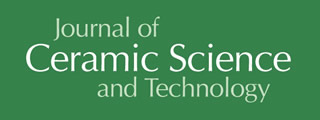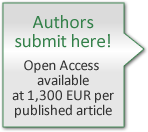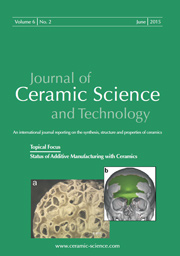Articles
All articles | Recent articles
Effects of Copper Oxide Content in AgCuO Braze Alloy on Microstructure and Mechanical Properties of Reactive-Air-Brazed Ba0.5Sr0.5Co0.8Fe0.2O3-δ (BSCF)
A. Kaletsch, A. Bezold, E.M. Pfaff, C. Broeckmann
Institute for Materials Applications in Mechanical Engineering, RWTH-Aachen University
received January 12, 2012, received in revised form January 24, 2012, accepted February 17, 2012
Vol. 3, No. 2, Pages 95-104 DOI: 10.4416/JCST2012-00001
Abstract
For the joining of ceramic materials as well as ceramics and metals, reactive air brazing (RAB) is an important improvement compared to existing brazing technologies. In contrast to commonly used active brazing processes, no vacuum atmosphere is needed in RAB. This is a crucial factor for certain materials, such as some functional ceramics, which cannot be brazed in vacuum easily because they are thermodynamically unstable in atmospheres of low oxygen partial pressure. Sometimes for those materials, RAB is the only possibility to obtain a gas-tight sealing, which works safely up to high temperatures.
This paper presents current research findings concerning the influence of the copper oxide (CuO) content in AgCuO braze on the microstructure of the brazing zone and the mechanical properties of reactive-air-brazed ceramic/metal joints. The joining components are the perovskite-type ceramic Ba0.5Sr0.5Co0.8Fe0.2O3-δ (BSCF) and the heat-resistant austenitic steel AISI 314. As braze materials, mixtures of silver with CuO contents between 1 mol% and 16 mol% were used.
The present study shows that a higher CuO content in the braze results in better wettability. However, a change in the microstructure of the ceramic can be observed, which becomes more pronounced with increased CuO concentration. This change in microstructure is characterized by higher and irregularly distributed porosity and increased grain sizes with copper cobalt oxide phases at the grain boundaries. Mechanical tests show that this reaction area leads to lower mechanical strength of the bonded specimens.
![]() Download Full Article (PDF)
Download Full Article (PDF)
Keywords
RAB, reactive air brazing, perovskite, BSCF, CuO
References
1 Ovenstone, J., Jung, J., White, J.S., Edwards, D.D., Misture, S.T.: Phase stability of BSCF in low oxygen partial pressures, J. Solid State Chem., 181, 576 – 586, (2008).
2 Kneer, R., Toporov, D., Förster, M., Christ, D., Broeckmann, C., Pfaff, E.M., Zwick, M., Engels, S., Modigell, M.: OXYCOAL-AC: Towards an integrated coal-fired power plant process with ion transport membrane based oxygen supply, Energ. Environ. Sci., 198 – 207, (2010).
3 Dabbarh, S., Pfaff, E.M., Ziombra, A., Bezold, A.: Brazing of MIEC ceramics to high temperature metals, ceramic transactions, Wiley-VCH, 213 – 223, (2010).
4 Wang, H., Cong, Y., Yang, W.: Oxygen permeation study in a tubular Ba0.5Sr0.5Co0.8Fe0.2O3-δ oxygen permeable membrane, J. Membrane Sci., 210, 259 – 271, (2002).
5 Shao, Z., Yang, W., Cong, Y., Dong, H., Tong, J., Xiong, G.: Investigation of the permeation behavior of a BSCF oxygen membrane, J. Membrane Sci., 172, 177 – 188, (2000).
6 US-Patent No. US 7,055,733 B2, Weil et al.: Oxidation ceramic to metal braze seals for applications in high temperature electrochemical devices and method of making, (2006).
7 Kim, J.Y., Hardy, J.S., Weil, K.S.: Effects of CuO content on the wetting behavior and mechanical properties of a Ag-CuO braze for ceramic joining, J. Am. Ceram. Soc., 88, 2521 – 2527, (2005).
8 Weil, K.S., Hardy, J.S., Rice, J.P., Kim, J.Y.: Brazing as a means of sealing ceramic membranes for use in advanced coal gasification process, Fuel, 85, 156 – 162, (2006).
9 Weil, K.S., Coyle, C.A., Darsell, J.T., Xia, G.G., Hardy, J.S.: Effects of thermal cycling and thermal aging on the hermeticity and strength of silver-copper oxide air-brazed seals, J. Power Sources, 152, 437 – 447, (2005).
10 Schüler, C.C., Stuck, A., Beck, N., Keser, H., Täck, U.: Direct silver bonding – an alternative for substrates in power semiconductor packaging, J. Mater. Sci.: Mater. El., 11, 389 – 396, (2000).
11 Hardy, J.S., Kim, J.Y., Weil, K.S.: Joining mixed conducting oxides using an air-fired electrically conductive braze, J. Electrochem. Soc., 151, [8], J43 – J49, (2004).
12 Weil, K.S., Hardy, J.S., Kim, J.Y.: Development of brazing technology for use in high-temperature gas separation equipment, 17th annual conference on fossil energy materials, Baltimore, MD (US), 04/22/2003 – 04/24/2003
13 Weil, K.S., Hardy, J.S.: Development of a new ceramic-to-metal brazing technique for oxygen separation/generation applications, 16th annual conference on fossil energy materials, (2002).
14 Bobzin, K., Schläfer, T., Kopp, N.: Thermochemistry of brazing ceramics and metals in air, Int. J. Mater. Res., 102, 972 – 976, (2011).
15 Kaletsch, A., Pfaff, E.M., Broeckmann, C., Nauels, N., Modigell, M.: Pilot module for oxygen separation with BSCF membranes, dechema (Eds.): Book of extended abstracts: Efficient carbon capture for coal power plants, 137 – 143, (2011).
16 Pfaff, E.M., Kaletsch, A., Broeckmann, C.: Design for a MIEC oxygen transport membrane pilot module, Chem. Eng. Technol., article in press
17 Stephens, J.J., et al.: Update on creep of silver alloy, Internal memo to M.K. Neilsen, Sandia national laboratories, (1996)
18 Malzbender, J., Huang, B., Moench, B., Steinbrecht, R.W.: A comparison of results obtained using different methods to assess the elastic properties of ceramic materials exemplified for Ba0.5Sr0.5Co0.8Fe0.2O3-δ, J.Mater. Sci., 45, 1227 – 1230, (2010).
19 Kim, J.Y., Hardy, J.S., Weil, K.S.: Silver-copper oxide based reactive air braze for joining yttria-stabilized zirconia, J. Mater. Res., 20, [3], (2005).
20 Driessens, F.C.M., Rieck, G.D., Coenen, H.N.: Phase equilibria in the system cobalt oxide/Copper Oxide in Air, J. Inorg. Nucl. Chem., 30, 747 – 753, (1968).
21 Zabdyr, L.A., Fabrichnaya, O.B.: Phase equilibria in the cobalt oxide – copper oxide system, J.Phase Equilib., 23, [2], (2002).
Copyright
Göller Verlag GmbH
Acknowledgments
The authors gratefully acknowledge financial support by DFG under contract No. PAK 524.


